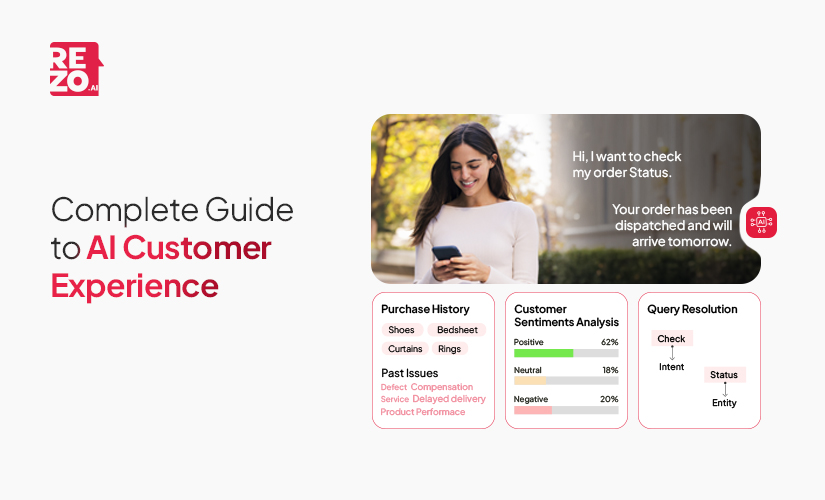
How Customer Sentiment Analysis Can Improve Customer Experience

How Customer Sentiment Analysis Can Improve Customer Experience


"Thank you for assisting me in resolving my problem."
When Neha concluded her customer service call with a statement of gratitude, it was a clear indicator of her satisfaction with the support she received. Her positive feedback underscores the pivotal role of effective customer interactions in shaping user experiences and satisfaction.
Customer emotions are not just pivotal; they are transformative for businesses aiming to refine strategies and pinpoint operational improvements. In the dynamic landscape of Artificial Intelligence, technologies like Natural Language Processing (NLP) are at the forefront of innovation. NLP is adept at discerning and analyzing the nuances of customer emotions, converting these intricate behavioral signals into actionable data.
By leveraging NLP, enterprises can tap into a deeper understanding of their customers' sentiments, opinions, and attitudes. This isn't merely about data collection; it's about transforming insights into a robust strategy that enhances every customer interaction. Armed with this intelligent analysis, businesses are not only equipped to offer solutions that are highly targeted and effective but also foster stronger, more meaningful customer relationships.
Quick Read: The Role of Natural Language Processing in AI-Driven Contact Centers
Embracing AI in this capacity means transforming customer service centers into hubs of predictive and responsive operations, significantly boosting efficiency and customer loyalty—a direct investment into the enterprise's future. Let’s take a closer look what customer sentiment analysis looks like in this blog.
What is Customer Sentiment Analysis?
In the rapidly evolving landscape of customer interactions, Customer Sentiment Analysis, or Opinion Mining, stands out as a beacon of innovation and insight. At the heart of this technology is the power to decode the language of your customers, transforming their words, tones, and emotions into actionable data that propels your business forward.
Understanding your customer's perceptions is not just beneficial; it's essential. Through the lens of Customer Sentiment Analysis, you can sieze a crystal-clear view of how your brand resonates in the marketplace. It's about diving deep into the core of your customer's thoughts and feelings, unveiling the honest sentiment behind every comment, review, and feedback.
Imagine having the ability to answer pivotal questions with confidence and precision:

These aren't just questions. They are the keys to unlocking a deeper understanding of your customer base, refining your strategies, and tailoring your services to meet and exceed the evolving demands of your market.
Leveraging sentiment analysis, we move beyond mere transactions to foster genuine connections. By accurately gauging customer satisfaction, we can enact swift, informed decisions that enhance customer experiences, boost loyalty, and ultimately drive your company's ROI.
Welcome to the future of customer interaction. Here, every opinion is mined for its golden insight, ensuring your company does not just respond to its audience but evolves with it. This is not just data analytics; it's the heartbeat of your brand's relationship with those it serves. With sentiment analysis, you're not just staying ahead of the curve; you're redefining it.
Quick Read: How to Understand and Implement on Customer Needs
How Does Customer Sentiment Analysis Work?
At the forefront of customer interaction and engagement, Customer Sentiment Analysis emerges as a cornerstone of understanding and innovation. Leveraging the robust capabilities of machine learning algorithms, such as Natural Language Processing (NLP), this technology delves deep into the realm of emotions, classifying sentiments into categories that range from positive and neutral to negative. NLP stands as a testament to the seamless integration of computer science and linguistics, offering a sophisticated lens to interpret the intricacies of human language in an unprecedented manner. This powerful AI-driven approach processes vast volumes of customer data efficiently, providing enterprises with a nuanced understanding of their clientele's sentiments in record time.
Let's explore this transformative technology through the prism of sample customer feedback
- Positive: "Thank you so much for helping me with my query" reflects satisfaction and gratitude, signaling successful interaction.
- Neutral: "Thanks for your quick response. I understand what you are trying to say," indicates acknowledgement without strong emotional engagement.
- Negative:"I didn't expect this kind of response and service from your customer care," expresses dissatisfaction, highlighting areas for improvement.
These insights serve as a window into the minds and hearts of your customers, providing invaluable perspectives on their experiences and expectations from your brand.
The journey to unlock these insights follows a streamlined process:
- Eliminate extraneous elements, like unnecessary words and symbols, to sharpen the focus of our analysis.
- Break down the text into clear, manageable units — words or phrases — to prepare for in-depth review.
- Identify and isolate key features, such as specific phrases and terminology, crucial for decoding sentiment.
- Organize these features into distinct sentiment classifications, paving the way for systematic analysis and actionable insights.
By embracing this approach, organizations unlock a transformative capacity to understand their customer base deeper, crafting experiences that resonate and reinforce loyalty. This isn't merely about analyzing text; it's about establishing a dialogic relationship with your customers, where their voices lead the way to service enhancement and innovation.
Also Read: How to Measure Customer Satisfaction
Types of Customer Sentiment Analysis

Here's a concise breakdown of the four main types of customer sentiment analysis, each a crucial piece in the puzzle of customer interaction enhancement:
- Fine-Grained Analysis: This method delves beyond the basic positive, negative, or neutral classifications, offering a spectrum of emotions such as "very positive" or "somewhat negative." It's designed for those seeking a more nuanced understanding of customer feelings, enabling tailored responses that resonate on a deeper level.
- Emotion Detection: By identifying specific emotions like happiness, anger, or disappointment, emotion detection offers a direct window into the hearts of your customers. This approach empowers businesses to craft empathetic, personalized experiences that connect and convert.
- Aspect-Based Analysis: This sophisticated analysis goes one step further by pinpointing the exact aspects of a product or service that are triggering particular sentiments. It's a game-changer for businesses aspiring to pinpoint and perfect every facet of the customer experience.
- Intent Analysis: Uncovering the intent behind customer interactions, this analysis helps predict potential actions, whether a customer is likely to purchase again, unsubscribe, or require support. It's invaluable for proactive engagement and for fostering loyalty through anticipation and understanding of customer needs.By integrating these four pillars of customer sentiment analysis, enterprises gain unparalleled insight, paving the way for enhanced satisfaction, loyalty, and ROI.
Quick Read: 15 Customer Retention Strategies that work
Importance of Customer Sentiment Analysis for Enterprises
In the dynamic world of enterprise-level business, understanding and harnessing the power of customer sentiment cannot be overstated. Here are the top 5 reasons why customer sentiment analysis is indispensable for enterprises:
- Enhanced Customer Understanding: Dive deep into the heart of what your customers truly feel and want, enabling you to tailor your strategies and products to meet their precise needs. Sentiment analysis provides a detailed map of customer emotions, offering a direct line to improved engagement and satisfaction.
- Proactive Issue Resolution: By capturing and analyzing customer sentiment in real time, enterprises can identify and address potential issues before they escalate. This proactive approach not only saves resources but also strengthens customer trust and loyalty, laying the foundation for long-term relationships.
- Data-Driven Decision Making: Equip your decision-makers with the power of actionable, sentiment-driven insights. Whether it’s refining product offerings or optimizing marketing strategies, sentiment analysis ensures that every decision is informed by the authentic voices of your customers.
- Competitive Edge: In today's highly competitive market, staying ahead means understanding your customers better than anyone else. Sentiment analysis offers a window into the customer psyche, providing a strategic advantage that can propel your enterprise to the forefront of your industry.
- Boosted ROI: At the end of the day, the ultimate goal is to drive growth and profitability. By aligning products, services, and customer experiences with the insights gleaned from sentiment analysis, enterprises can enhance customer loyalty, attract new business, and secure a healthier bottom line.
How Can Sentiment Analysis Used to Improve Customer Experience?
In navigating the intricate world of customer sentiment, enterprises stand at the brink of transformative opportunity. With insights powered by Rezo.AI, businesses can not only decode but also anticipate the evolving needs and emotions of their customers. Here are five pivotal tips and strategies for harnessing the exceptional power of customer sentiment analysis, tailor-made for the forward-thinking enterprise:
- Integrate Across Channels: Customer sentiment is omnipresent – from social media to support tickets. Deploy an integrated approach to capture this valuable data across all touchpoints. Rezo.AI’s platform excels in aggregating and analyzing these diverse data streams, ensuring no sentiment goes unnoticed.
- Leverage Real-Time Analysis: In the digital age, timing is everything. Utilize real-time sentiment analysis to identify and act on customer sentiments as they emerge. This immediate response capability not only preemptively addresses potential issues but also capitalizes on positive sentiment to enhance customer engagement.
- Automate for Efficiency: Manually analyzing sentiment is a task of the past. Automation, powered by AI, scales your analysis capabilities without sacrificing precision. With Rezo.AI, unleash the efficiency of automated sentiment analysis, freeing your team to focus on strategy and innovation.
- Deep Dive with AI-driven Insights: Beyond surface-level sentiment, lies a wealth of deep, actionable insights. Leverage the advanced AI capabilities of Rezo.AI to uncover the underlying drivers of customer emotions, enabling strategic adjustments that resonate authentically with your audience.
- Close the Feedback Loop: Sentiment analysis is not just about listening; it’s about action. Ensure that the insights gained are looped back into your business processes. From product development to customer service, let customer sentiment be your guide to continuous improvement and innovation.
Adopt these strategies with Rezo.ai at your side, and watch as the tapestry of customer sentiment unfolds into a roadmap for unparalleled engagement and success. Embrace the future of customer interaction, where every sentiment analysis translates into meaningful connections and quantifiable growth.
Frequently Asked Questions (FAQs)

Take the leap towards innovation with Rezo.ai
Get started now














